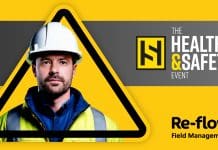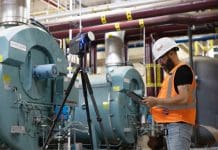Dr Hugh Datson, Principal Environmental Scientist, DustScan Ltd discusses the necessary steps to mitigate and manage dust on construction sites
For any construction site, the planning process should enable potential environmental impacts from the development to be evaluated, mitigated and measured appropriately and in relation to the scale of the possible impacts.
One of those impacts is from dust because, by their very nature, works at almost any construction site have the potential to generate dust. Unless located in a very sheltered location a long way from neighbours, dust from construction activities can affect off-site receptors. Such impacts can occur as visible soiling, causing complaints and annoyance (‘nuisance’ dust), or pollution to air and sensitive environments (breach of regulatory limits).
Any procedure for dust management at a construction site will be developed through three logical stages: assessment, mitigation and monitoring. In other words, once the nature and scale of the possible impacts have been assessed, controls should be implemented to reduce them to acceptable levels, and consequently the efficacy of the mitigation measures should be evaluated to ensure that they are effective and appropriate.
There is plenty of good guidance for dust assessment, mitigation and monitoring, but it’s important that any procedures implemented from this are commensurate to the scale of the operation and the potential impacts.
For the first stage, Dust Assessment (DA), the Institute of Air Quality Management (IAQM) offers a valuable resource at a national level: Guidance on the Assessment of Dust from Demolition and Construction. For London, there is the Mayor’s Supplementary Planning Guidance: The Control of Dust and Emissions during Construction and Demolition, and local authorities throughout the UK issue specific documentation for construction projects within their boundaries.
As noted by the IAQM, however, technical competence is essential in carrying out such assessments. Central to this is the realisation that just because guidance exists, it shouldn’t be followed blindly but should be used with intelligence; the assessor needs to understand the nature of the works envisaged, how and in what manner dust might be generated, what impacts might occur, how they can be reasonably managed and how they can be shown to be effective.
Forming part of the planning process, the DA for the development is likely to require acceptance by the appropriate regulatory body, or bodies. From this, the second stage of the process (i.e. dust management) sets out the controls on dust generation. These should be documented by means of a Dust Management Scheme (DMS) which should show how each of the dust risks identified in the DA can be managed. Many firms ensure environmental compliance throughout their organisation by means of an Environmental Management Scheme (EMS) to a standard such as ISO 14001; in such circumstances the DMS should be tailored to fit with the company’s EMS.
The London SPG includes a comprehensive list of methods for dust management, but as with dust assessment it is essential that such measures should be applied appropriately to the site in question, not quoted verbatim from the guidance.
Thirdly, ensuring that the DMS is effective requires monitoring and evaluation. As before, this should be formally documented, this time as a Dust Monitoring Plan (DMP). Also as before, it is essential that the DMP is drawn up competently, by including methods that are appropriate for the nature of the risks posed by the site and the mitigation applied.
Dust monitoring can therefore range from the very simple, such as visual observation, right through to real-time instrumentation that provides automatic alerts if a trigger level is breached. The IAQM also provides excellent guidance on this topic: see Guidance on Air Quality Monitoring in the Vicinity of Demolition and Construction Sites.
In conclusion, therefore, the potential for dust from construction sites can be acknowledged, and managed by means of assessment, mitigation and monitoring plans. Whilst guidance in carrying out such plans is widely available, they will be most effective – both in terms of cost and efficacy – if carried out with a thorough understanding of the issues involved.
Sometimes knowledge of how to apply guidance and put into place appropriate plans resides within the company making the application, but more often than not, the specialist knowledge required to meet guidance criteria and to minimise costs of monitoring and mitigation is not readily within the organisation, and it is in these cases where the services of a dust consultancy such as DustScan AQ can be used to best effect.
Dr Hugh Datson
Principal Environmental Scientist
DustScan Ltd
Hughd@dustscan.co.uk
Please note: this is a commercial profile













